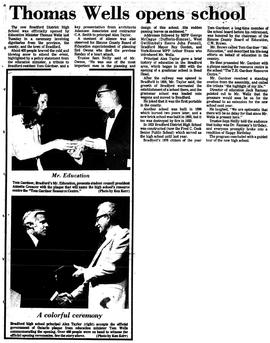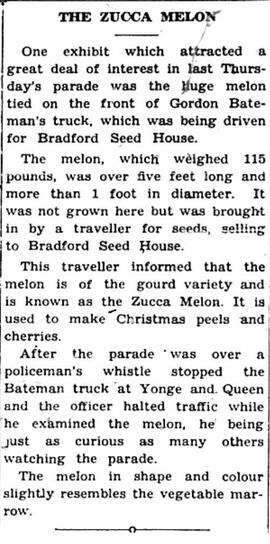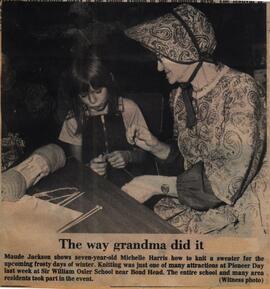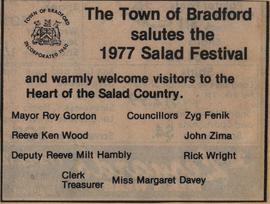Description : The Holland Marsh Story
(Continued from last week)
Chapter VI.
ACTION
In 1924, West Gwillimbury residents elected a new council. Mr. J.F. Hambly became reeve, with L.A. Neilly (Gilford), Percy Selby, W.J. Dales and the late Herman Lennox, the Councillors. These names, in marshland history are memorable, because it was this council which took the initiative in the Holland Marsh Drainage Scheme.
Soon after assuming office in 1924, these Councillors were presented with a petition signed by approximately 90% of the marsh landowners, asking that an engineer be appointed and a survey be made to ascertain the approximate estimate of the cost of a drainage scheme for the marsh. Owing to the large percentage of owners who signed the petition, Council felt justified in acceding to the request.
Alexander Baird, engineer, gave the first estimates and reported to West Gwillimbury Council, which body fulfilled the necessary legal requirements, holding Court of Revision, passing a By-Law authorizing the scheme and advertising for tenders for the work of draining the marsh according to the engineer's report. An appeal against the report was made by King Township Council and the case was tried before the Drainage Referee on March 4, 1925, when the appeal was dismissed.
Reeve Hambly and members of Council worked untiringly to acquaint themselves with marsh drainage projects in south-western Ontario and the more they investigated, the more enthusiastic they became regarding the prospects locally.
Regarding the actual work of drainage on the marsh, two motions on West Gwillimbury Minute Book record the letting of contract and the payment for same.
May 16, 1925, on motion of Councillors Neilly and Dales, the following motion was passed: "That the tender of Cummings and Robinson (Toronto) be accepted subject to the disposal of any motion to quash the By-Law and that Engineer Alex. Baird and our solicitor be instructed to prepare the necessary contract of work."
On March 4, 1929, the Treasurer was authorized to pay the contractors, Cummings and Robinson, "the sum of $6,500 balance of their account in full settlement of all claims and demands of every nature and kind whatsoever in connection with the Holland Marsh Drainage Scheme."
According to a 1929 newspaper, the amount of the entire contract was $137,000, which, together with engineering, legal and other expenses, made the reclamation cost about $21.00 per acre of land reclaimed. The money for this work was borrowed on the credit of the municipalities concerned and charged against the land, with debentures to run for 30 years. Of this, the Ontario Government contributed 20% of the cost of work in accordance with the provisions of the Municipal Drainage Act, which empowered the Government to do so.
West Gwillimbury being the municipality petitioned by the landowners became the initiating municipality in the work of reclamation, but cost was borne proportionately by King Township.
Bradford Scheme
The Bradford, or Little Scheme, comprises some 200 acres of Bradford marsh lands, and, according to the Drainage Act, this could not be included in the Township scheme. When this fact was discovered, the owners in the Bradford area petitioned Bradford Council, in July 1925, to have this land reclaimed. The late Mr. Denis Nolan was then Reeve of Bradford.
Work on the Bradford Scheme went forward quickly, the cost of drainage being approximately $11,000, on which a Government grant of 20% was also applicable. By 1927, the Bradford Marsh grew its first crop of vegetables.
Chapter VII
PROF. DAY REPORTS ON EARLY CROP AND VISIONS FUTURE
No story of the Holland Marsh would be complete without reference to Professor W.H. Day.
The first day the writer was in Bradford, the future of the marsh was "sold" to him while listening to an address by Professor Day, who told of the success of his first big marsh harvest in the Autumn of 1930. Following that 1930 harvest, Professor Day reported, at the request of the Holland Marsh Drainage Commission, at both West Gwillimbury and King Township Nominations as follows:
"A few days ago, the Holland Marsh Drainage Commission asked me if I would appear at this nomination and give the ratepayers a report of results being obtained on the Holland Marsh land. It is a pleasure for me to do this, for I feel that the municipalities which guaranteed the debentures are entitled to know how the development is proceeding.
Before entering into details, however, I should like to make a few observations of a general nature.
"In the first place, I wish to congratulate King, West Gwillimbury and Bradford on the appointment of the Holland Marsh Drainage Commission with full power under the Municipal Drainage Act to manage the drainage scheme and "do all things necessary for it successful operation." I also wish to congratulate the Commission on the energetic and business way in which they approached their task and carried it through to the present. Many of you know that early in 1929 the marsh land owners, being thoroughly dissatisfied with the way in which their interests were being looked after, formed a Marsh Land Owners Association, in order that they might make their wishes known to the municipalities. This Association instructed me, as its President, to attend the Gwillimbury Council meetings from time to time and lay its wishes before the Council. This I did on a number of different occasions. When we asked for a commission with full power to manage the scheme, a by-law was passed at one meeting, but repealed at the next, and another substituted. The second was little better than the first, for the powers given to the commissioners were so meager that two of those appointed refused to act. We were told that the Council could not appoint a commission with full powers. The Land Owners Association, early in 1930, sent me to consult the best drainage lawyer in Toronto, who said the Drainage Act specifically provided in schemes where pumping was required, the Council might appoint a commission with full powers and he drew up a suitable by-law, which we submitted to the Council and which they in turn submitted to the Drainage Referee of Ontario. The Referee made it plain that it was not his province to give advice tot he municipalities, but felt free to state that he saw no objection to the proposed by-law. The Council, feeling that it was now on safe ground, unanimously passed the by-law, appointing the present reeves of the three municipalities as commissioners, and the Marsh Land Owners Association takes this opportunity of stating that they are well satisfied with the work of the Commission, and hope that no change in its personnel will be made at the time. Not once since the Commission was appointed has it been necessary for the Association to make any representations either to the commissioners or to any of the councils.
Chapter VIII
$26,000 OFF 37 ACRES
"Let me now come to the marsh development itself. During the past season I had 37 acres in crop, as follows: Head lettuce, 22 acres; celery, 6.5 acres; onions, 4.5 acres; carrots, 2.5 acres; parsnips, 1.5 acres. The total crop harvested was parsnips, one carload; carrots, two carloads; onions, four; celery, 17, and lettuce, 26, making a total of 50 carloads. If this were all in one train, it would make a train almost one half mile long. Everything has now been marketed except the carrots and parsnips, which are in cold storage. The total cash receipts up to the present moment amount to $25,718, over and above the selling commissions of 12.5%. The carrots and parsnips when sold will bring the total to approximately $26,000. Divide this by 37 and we find the average yield to be $702 per acre. Compare that with your highland crops. With wheat at 70c a bushel, it would require a yield of 1,000 bushels per acre to equal our average marsh returns. Individual pieces have done much better than the average. One acre of lettuce yielded approximately $1-400; one-seventh acre of celery nearly $500; one and one-sixth acre of celery, $2,452, and 6.5 acres of celery, $10,412.
"In regard to lettuce, wholesale firms in Toronto state that never before has there been Canadian head lettuce on the Toronto market throughout the entire season. Bradford head lettuce appeared on July 11th and was on sale every day until October 11th. We had two acres of lettuce maturing each week for 11 weeks. It was our largest crop, both in acreage and in returns, bringing us $11,-867.78. We look forward to the time when Holland Marsh will supply the head lettuce for all Canada during the Summer season, instead of its being imported from California, Arizona and other American states.
"And yet on the average, lettuce was one of our poorest crops, yielding about $540 per acres, although individual pieces produced as high as $1,400 per acre. The reason for the unsatisfactory return on lettuce is not far to seek. Owing to the drought, a large percentage of the plants did not head properly. Needles to say, the cause of this is receiving our closest attention and we are devising ways and means of avoiding a like result in case of another drought.
"How do we propose to do this? By irrigation. Last summers, when we realized that a drought was on, we made a cut through the bank and let the water from the outside channel into our ditches. It spread out through them, and in a few days the soil, which had been dry and dusty on the surface, began to look moist as it became saturated with water. You see, the bottom of the ditches is about 2 1/2 feet below the lake level. The irrigation saved our celery from feeling the effects of the drought. But our inlet ditch was neither deep enough nor wide enough and so the water never reached the lettuce fields farther down. For next year, we have two inlets, each admitting four times as much water as the old one. We have just learned that in California, Arizona and other lettuce...










